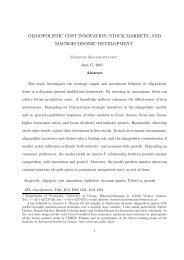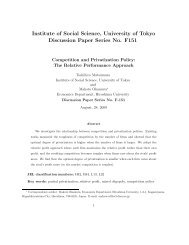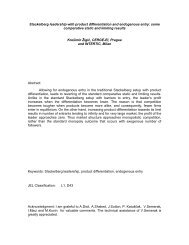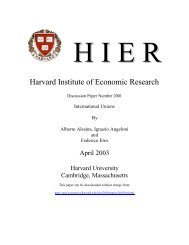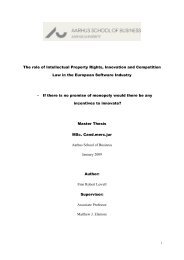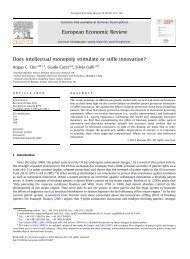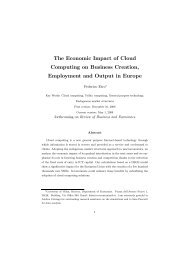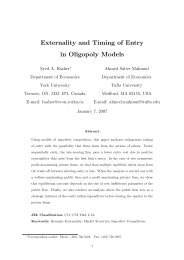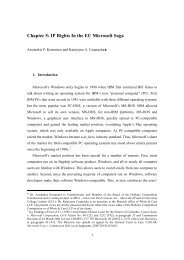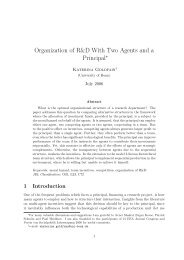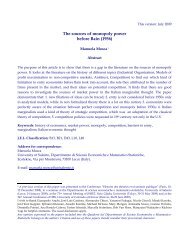The EU Approach to Abuse of Dominance - Intertic
The EU Approach to Abuse of Dominance - Intertic
The EU Approach to Abuse of Dominance - Intertic
Create successful ePaper yourself
Turn your PDF publications into a flip-book with our unique Google optimized e-Paper software.
positive efficiencies and consumer benefits. As seen above, the procompetitive effects <strong>of</strong> tying are<br />
particularly pronounced in the case <strong>of</strong> technical tying (when companies innovate by linking formerly<br />
separate technologies or products, efficiencies <strong>of</strong>ten emerge through improved performance and<br />
quality), but they also emerge because tying is <strong>of</strong>ten used as an aggressive strategy which leads <strong>to</strong> lower<br />
prices. While the Discussion Paper purports <strong>to</strong> adopt a more balanced approach that takes in<strong>to</strong> account<br />
that tying and bundling can be pro-competitive, we are concerned that this approach is not carried<br />
through in<strong>to</strong> the details <strong>of</strong> the analysis. A close reading suggests that certain older presumptions against<br />
tying remain embedded in the analysis, which, taken <strong>to</strong>gether, risk perpetuating the current situation in<br />
which tying and bundling are viewed as suspect unless proven otherwise.<br />
We have doubts on the same definition <strong>of</strong> tying, which places <strong>to</strong>o much emphasis on consumer<br />
demand for the tied product. Such demand does not shed light on whether there exist distinct products<br />
for the purposes <strong>of</strong> tying analysis, which uses the distinct products test as a proxy for determining<br />
whether the tying arrangement produces efficiencies. In other words, while there is clearly consumer<br />
demand for shoelaces, this should not mean that shoes and shoelaces are distinct products for the<br />
purposes <strong>of</strong> tying analysis. This issue can only be addressed by asking whether there is consumer<br />
demand for shoes without shoelaces. In sum, whether or not consumer demands exists for the tied<br />
product is the wrong question; the correct question is whether there is any significant consumer<br />
demand for the tying product without the tied product. Unless the analysis focuses on this question,<br />
there is a danger that the mere existence <strong>of</strong> consumer demand for the tied product may prevent the<br />
emergence <strong>of</strong> efficient tying arrangements and end up protecting suppliers <strong>of</strong> tied products at the<br />
expense <strong>of</strong> consumers and innovation. In the case <strong>of</strong> technical integration <strong>of</strong> two products that were<br />
previously distinct, the distinct products test itself may not be helpful for understanding market<br />
dynamics because, by definition, this test is backward-looking. A better approach in these cases would<br />
be simply <strong>to</strong> ask whether the company integrating the previously distinct products can make a plausible<br />
showing <strong>of</strong> efficiency gains: since technical tying is normally efficient, market leaders would be able <strong>to</strong><br />
continue producing innovative products benefiting consumers without running afoul <strong>of</strong> the<br />
prohibitions on tying.<br />
Moreover, the treatment <strong>of</strong> “commercial usage” in the context <strong>of</strong> market foreclosure does not<br />
reflect the economics <strong>of</strong> tying. According <strong>to</strong> the Discussion Paper, the sale <strong>of</strong> a tied product by a<br />
dominant company may be an abuse, even when it is standard commercial practice (# 182).<br />
Furthermore, the fact that a competi<strong>to</strong>r ties may add <strong>to</strong> the foreclosure effect (# 197). This overlooks<br />
that in practice, the cus<strong>to</strong>mary nature <strong>of</strong> bundling is evidence that such tying generates efficiencies, or<br />
that there is no demand for the unbundled product. If there were sufficient cus<strong>to</strong>mer demand <strong>to</strong> make<br />
the supply <strong>of</strong> the unbundled product pr<strong>of</strong>itable, competi<strong>to</strong>rs <strong>of</strong> the dominant company would most<br />
likely avail themselves <strong>of</strong> this business opportunity.<br />
19



